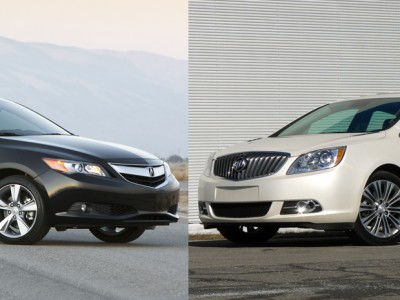Comparo: 2013 Acura ILX Dynamic vs. 2013 Buick Verano Turbo
Story by John LeBlanc
At one time, there were just compact cars. Then there were small and luxurious or premium compact cars. Now we have the niche-within-the-niche premium sports compact cars, a segment set to explode with the likes of Audi, BMW and Mercedes-Benz moving downmarket.
Until then, though, we have the new-this-year 2013 Acura ILX Dynamic and Buick Verano Turbo, a pair of compact sedans that profess to be both sporty and luxurious. As I like to do, I asked which one was the best.

SECOND PLACE: 2013 Acura ILX Dynamic
The new ILX replaces the slow-selling CSX as the starter sedan in Acura’s lineup. Like the CSX — and its predecessors dating back to the 1997 EL — the new ILX is heavily based on the Honda Civic compact sedan. This time, though, parent Honda has spent more effort distinguishing its pair of front-wheel-drive, five-passenger sedans, as the ILX gets unique sheetmetal all around.
Including a $1,945 transport and pre-delivery inspection charge, ILX pricing starts at $29,735 and ends with the $36,935 gas-electric Hybrid. To best match the sportiest Verano, we drove the sportiest ILX, the $31,935 Dynamic, which adds a larger four-cylinder engine mated to a six-speed manual transmission, metal racing pedals, one-inch larger 17-inch wheels and tires and other details.
If you like to change your own gears, we’d recommend the Acura gearbox over the Buick. Like the same manual transmission in the $27,685 Civic Si, the ILX Dynamic’s shifter is precise and sure in its actions.

The same 2.4-litre four-cylinder found in the Civic Si and the $35,995 Acura TSX also powers the ILX Dynamic. While the bigger mill makes 51 more horsepower and 30 more pound-feet of torque than the base ILX’s 2.0 L four, that’s way shy of the Verano Turbo’s ratings. And the rest of the “sport” side of the ILX Dynamic’s “premium sport” portfolio comes up short as well.
The Acura’s electric steering can’t make up its mind. Straight ahead, it’s like a laser, but turn the wheel off centre and it goes feather-light. Keep turning, and the steering goes heavy again. The ILX Dynamic’s suspension tuning seems to fighting with itself as well: too soft when cornering hard, but allowing sharp impacts to be felt by its occupants.
And for a so-called “premium compact”, the Acura is decidedly nosier on the road than the Buick. Even in top gear — sixth — you’ll want to shift up to calm down the ruckus from the engine. Or better yet, shift over to your local Buick dealer …

FIRST-PLACE: 2013 Buick Verano Turbo
Like the Acura, the Buick uses a more plebeian car’s platform, as in the Chevrolet Cruze, as a base. However, as the Verano was designed for status-seeking customers in China, it offers a more luxurious driving experience than the Acura, and the Turbo version simply adds more performance.
With a $1,550 transport and PDI fee, Veranos start at just $22,895. At $32,450, the top-line Verano Turbo is competitively priced with the ILX Dynamic, but it beats the Acura in value with standard kit, including larger 18-inch tires, a rear backup camera, side blind spot detection and rear cross-traffic alert. As well, the Buick offers luxury car options like a navigation system and the choice of a no-cost automatic with the same number of gears. And don’t be fooled by their respective brand names: both the “Japanese” Acura and “American” Buick are built in the U.S., and the difference in interior build quality and use of quality materials is a virtual dead heat.

Besides its unique styling, the Acura doesn’t act that much different than the Honda it’s based upon. But the Buick feels more upscale than the mainstream Chevy. As we mentioned, the Verano Turbo’s cabin is quieter than the ILX Dynamic, and it also offers more interior room. The Buick’s suspension is more absorptive of bad pavement than the Acura, too, with well-controlled body motions. And while driving enthusiasts will want more steering feel, at least the Verano Turbo tiller’s actions are linear and predictable.
The Acura and Buick post similar fuel economy estimates — 9.8 L/100 km city/6.5 highway and 10.2/6.3, respectively. But the Verano Turbo’s more powerful 250-hp and 260 lb-ft turbocharged 2.0L four enables it to scoot from zero to 100 km/h in only 6.4 seconds — 0.8 quicker than the ILX Dynamic.
If the Buick Verano Turbo has any faults, it’s in the fact that beyond its straight-line speed advantage, there’s little to distinguish the Turbo’s driving experience from less-sportier Verano models. There’s the “T” on its rump, plus dual exhaust pipes, sport pedals and a rear spoiler, but the car still leans toward luxury when driven with vigour. Perhaps its needs two more letters (i.e. a more buttoned-down “GS” model) to make the Verano Turbo the near-perfect “premium sport compact” sedan. Regardless, the Buick is definitely a better choice than the Acura.
Comments
One Response to “Comparo: 2013 Acura ILX Dynamic vs. 2013 Buick Verano Turbo”






![[del.icio.us]](https://www.straight-six.com/wp-content/plugins/bookmarkify/delicious.png)
![[Digg]](https://www.straight-six.com/wp-content/plugins/bookmarkify/digg.png)
![[Facebook]](https://www.straight-six.com/wp-content/plugins/bookmarkify/facebook.png)
![[Google]](https://www.straight-six.com/wp-content/plugins/bookmarkify/google.png)
![[Reddit]](https://www.straight-six.com/wp-content/plugins/bookmarkify/reddit.png)
![[StumbleUpon]](https://www.straight-six.com/wp-content/plugins/bookmarkify/stumbleupon.png)
![[Twitter]](https://www.straight-six.com/wp-content/plugins/bookmarkify/twitter.png)
![[Email]](https://www.straight-six.com/wp-content/plugins/bookmarkify/email.png)
September 28th, 2013 @ 9:15 am
The Verano Turbo just oozes luxury. Sometimes at a stoplight I’ll just shut off the radio to set in pure silence as the motor is running you won’t even know it is so quiet. And quick too with nicely weighted driving dynamics it is joy to drive. The fuel economy on my 6-speed is amazing as I was able to squeeze 39+ mpg out of a tank. But usually see mid-to-upper 30’s on my mostly highway commute.
I love the back up beeper and camera as I can watch the dog run out of the way.